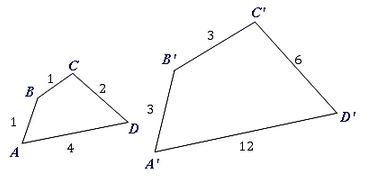Similar figures
Recall from our previous lesson that two shapes, or figures, are said to be similar if they are the same shape but different sizes. Two key features of similar figures are:
- Corresponding angles are equal
- Corresponding sides are proportional, meaning they have been multiplied by the same scale factor.
Similar shapes are either enlargements or reductions of one another.
The two polygons in this interactive tool are similar. We can look at their relative sizes with different scale factors.
Enlargements
A shape is considered an enlargement of another if one shape has side lengths that are all increased by the same scale factor.
Example
Take a triangle with side lengths measuring $3$3 cm, $4$4 cm and $5$5 cm. If each side is multiplied by the same factor, say $2$2, the new resulting triangle will have side lengths measuring $6$6 cm, $8$8 cm and $10$10 cm. The resulting shape is larger.
Reductions
A shape is considered a reduction of another if one shape has side lengths that are all decreased by the same scale factor.
Consider the reverse of the above example: a triangle with side lengths measuring $6$6 cm, $8$8 cm and $10$10 cm has each side multiplied by a factor of $\frac{1}{2}$12. The new resulting triangle will have side lengths measuring $3$3 cm, $4$4 cm and $5$5 cm. The resulting shape is smaller than the original.
The scale factor tells us by how much the object has been enlarged or reduced.
If the scale factor is greater than $1$1, the image is being made bigger than the original.
If the scale factor is smaller than $1$1, the image is being made smaller than the original.
Worked example
Example 1
The shape $ABCD$ABCD has been transformed to $A'B'C'D'$A′B′C′D′.
a) Are the two shapes similar?

Think: To check if two shapes are similar each pair of corresponding sides must be in the same proportion. Identify corresponding sides, in some cases this might mean rotating or reflecting the shape, and compare the ratios of the matching sides.
Do:
| Side | Length | Side | Length | Scale factor |
|---|---|---|---|---|
| $AD$AD | $4$4 | $A'D'$A′D′ | $12$12 | $12\div4=3$12÷4=3 |
| $DC$DC | $2$2 | $D'C'$D′C′ | $6$6 | $6\div2=3$6÷2=3 |
| $CB$CB | $1$1 | $C'B'$C′B′ | $3$3 | $3\div1=3$3÷1=3 |
| $BA$BA | $1$1 | $B'A'$B′A′ | $3$3 | $3\div1=3$3÷1=3 |
Since all the ratios are the same, we can conclude that $ABCD$ABCD is similar to $A'B'C'D'$A′B′C′D′.
b) What is the scale factor to transform $ABCD$ABCD to $A'B'C'D'$A′B′C′D′?
Think: As we know the shapes are similar we can use the ratio of any two corresponding sides.
Do: The scale factor is $3$3. That is the shape $ABCD$ABCD has been enlarged by a factor of $3$3.
Practice questions
Question 1
The dimensions of the triangle shown are enlarged using a scale factor of $3.1$3.1.

What would be the new length of $AB$AB?
What would be the new length of $BC$BC?
What would be the new length of $CA$CA?
Question 2
The two figures to the right are similar.

Find the reduction factor. State your answer as a fraction.
Hence find the value of $m$m.
Question 3
Identify if quadrilateral $A'B'C'D'$A′B′C′D′ is a dilation of quadrilateral $ABCD$ABCD.
yes
Ano
B
Problem solving using similar triangles
The sides lengths of similar triangles are in the same ratio or proportion. So once we know that two triangles are similar, by using the properties from our previous lesson, we can find any unknown side lengths by using the ratio.
To reduce the number of steps required in problem solving start with the unknown in the numerator. For example, when solving for $y$y in the following diagram we can equate the ratio of the corresponding sides from the large triangle to the small triangle: $\frac{y}{10}=\frac{7}{4}$y10=74. Alternatively, we can equate the ratio of the sides within the large triangle to the corresponding ratio of sides within the smaller triangle $\frac{y}{7}=\frac{10}{4}$y7=104. With either set-up we can solve for $y$y in one step by multiplying both sides by the denominator of the left-hand side.
Practice questions
Question 4
A stick of height $1.1$1.1 m casts a shadow of length $2.2$2.2 m. At the same time, a tree casts a shadow of $6.2$6.2 m.

If the tree has a height of $h$h metres, solve for $h$h.
Question 5

